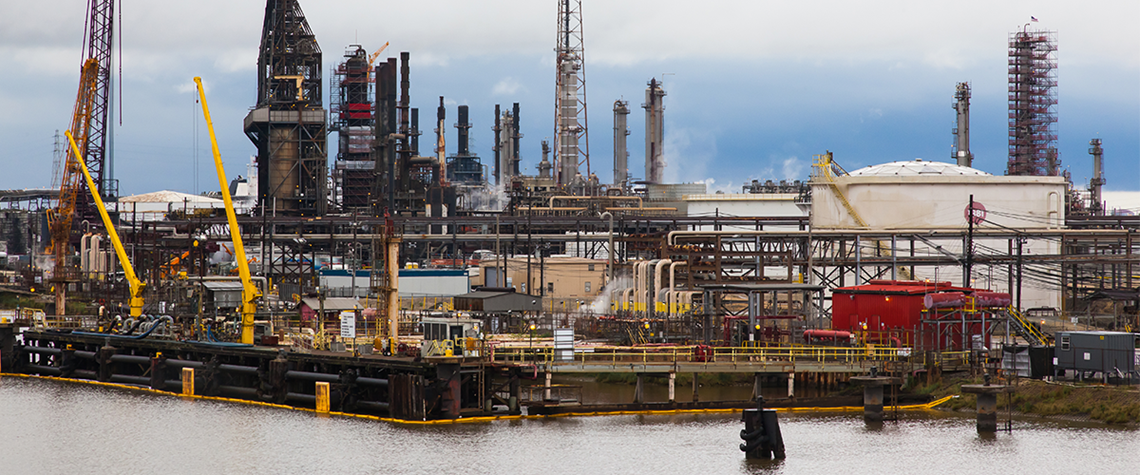
A fierce competition between ExxonMobil and Chevron is reshaping America's industrial landscape, as both oil majors race to build massive carbon capture networks along the US Gulf Coast. This rivalry isn't just about corporate positioning. It's driving the creation of critical infrastructure that could decarbonize America's heaviest industrial emitters.
The scale of their ambitions reveals how seriously these companies are taking the transition to lower-carbon operations. ExxonMobil is targeting 30 million tons of CO2 storage capacity per year by 2030, while Chevron initially aimed for 25 million tons annually.
ExxonMobil Takes the Lead in Carbon Infrastructure
ExxonMobil has pulled ahead in this decarbonization race through strategic acquisitions and rapid project development. The company's $4.9 billion purchase of Denbury in 2023 instantly gave it access to the largest CO2 pipeline network in North America, stretching over 1,300 miles across Louisiana, Texas, and Mississippi.
ExxonMobil's Gulf Coast Carbon Capture Portfolio:
- CF Industries Donaldsonville: 2.0 million tons/year (operational since July 2025)
- Linde Beaumont hydrogen plant: 2.2 million tons/year (2025 startup)
- Nucor Convent steel plant: 0.8 million tons/year (2026 startup)
- Baytown blue hydrogen project: 7.5 million tons/year (pending FID)
The company has already secured agreements for 9.8 million tons per year of CO2 capture from third-party industrial facilities. These aren't future promises. The CF Industries ammonia plant in Louisiana began capturing CO2 in July 2025, marking a tangible step forward in industrial decarbonization.
"We need to address the emissions associated with the combustion of oil and gas. Some define the issue as, 'We need to get rid of oil and gas.' The issue needs to be defined as addressing the emissions."
Darren Woods, ExxonMobil CEO
Chevron's Measured Approach Shows Promise
While ExxonMobil races ahead, Chevron is taking a more measured approach that may prove strategic in the long term. The company has shifted from rigid targets to flexible timing, describing its 25 million ton goal as a "north star" rather than a firm commitment.
Chevron's portfolio centers on three key projects. The Gorgon CCS facility in Australia, operational since 2019, provides 4 million tons of annual capacity. In the US, the company is developing the Bayou Bend project in Texas, targeting 5-10 million tons per year, and a smaller facility at Pascagoula refinery in Mississippi.
>> RELATED: How ExxonMobil’s Baytown Project Could Make the U.S. a Hydrogen Powerhouse

Building Industrial-Scale Solutions
What makes this competition significant isn't the corporate rivalry. It's the real-world infrastructure being built to serve America's hardest-to-decarbonize industries:
1. Steel manufacturing through Nucor's Louisiana plant partnership with ExxonMobil
2. Ammonia production via CF Industries' facilities in Louisiana and Mississippi
3. Power generation through partnerships with Calpine and other utilities
4. Refining operations across multiple Gulf Coast facilities
Hydrogen: The Next Frontier
Both companies are betting big on hydrogen as a decarbonization tool, though their approaches differ significantly. ExxonMobil's Baytown project represents the more aggressive strategy, aiming to produce 870,000 tons of blue hydrogen and 1 million tons of blue ammonia annually.
The project's final investment decision, expected by year-end, will signal whether large-scale hydrogen production is commercially viable. Success would position ExxonMobil as a global leader in industrial hydrogen supply.
Chevron is taking a more diversified approach with five hydrogen developments, including the Aces Delta green hydrogen project in Utah, which began operations this year with 36,500 tons of annual capacity.
Policy Support Drives Investment:
- 45Q tax credits provide up to $85 per ton for CO2 storage
- Hydrogen production tax credits support clean hydrogen development
- Federal hydrogen hubs program creates regional infrastructure networks
- State incentives in Texas and Louisiana accelerate project development
Lithium: Securing America's Electric Future
The competition extends beyond carbon capture into critical mineral extraction. Both companies are developing domestic lithium production from brine formations in Arkansas, reducing America's dependence on foreign sources for this essential battery material.
ExxonMobil leads with 240,000 acres in the Smackover Formation and plans to supply lithium for 1 million electric vehicles by the early 2030s. Chevron entered the sector this year with 125,000 acres in the same formation.

>> In Other News: AlliedOffsets And Sylvera Launch Quality-Weighted Carbon Price Index
Why the Gulf Coast Matters
The Gulf Coast's transformation into America's decarbonization hub isn't accidental. The region offers unique advantages that make large-scale carbon storage economically viable:
The area's geology provides ideal underground storage in depleted oil and gas reservoirs. Existing pipeline infrastructure can be repurposed for CO2 transport. Dense industrial clusters create economies of scale for capture projects.
Most importantly, the concentration of heavy industry creates immediate demand for decarbonization services. Steel plants, refineries, chemical facilities, and power generators all need solutions for their emissions.
| Company | Current CCS Capacity | 2030 Target | Key Projects |
|---|---|---|---|
| ExxonMobil | 9 million tons/year | 30 million tons/year | Baytown, LaBarge, Denbury network |
| Chevron | 4 million tons/year | 25 million tons/year | Gorgon, Bayou Bend, Pascagoula |
Market Reality Drives Strategic Shifts
Both companies acknowledge that policy support and market development remain crucial for project economics. ExxonMobil has warned that some projects could face delays if market conditions don't improve. Chevron has shifted to flexible timing for its carbon capture goals.
This pragmatic approach reflects the reality of building new industrial sectors. Technology costs must decline, carbon pricing must develop, and policy frameworks need stability to justify massive capital investments.

"We see carbon capture as a critical pillar of our lower carbon strategy. Our focus is on scalable solutions that will deliver meaningful emissions reductions, aligned with evolving market demand and policy frameworks."
Michael Wirth, Chevron CEO, 2025
Building Tomorrow's Energy Infrastructure Today
The competition between ExxonMobil and Chevron represents more than corporate rivalry. It's catalyzing the creation of industrial infrastructure that America needs to meet its climate goals while maintaining economic competitiveness.
Their projects are creating real jobs, real infrastructure, and real emissions reductions. Steel plants are capturing CO2 instead of releasing it. Ammonia facilities are storing emissions underground. Power generators are planning cleaner operations.
As these companies race to build America's carbon management infrastructure, they're proving that the energy transition doesn't require abandoning industrial expertise. Instead, it demands applying that knowledge to build the low-carbon economy that America needs for the future.
Subscribe to the newsletter
Daily decarbonization data and news delivered to your inbox
Follow the money flow of climate, technology, and energy investments to uncover new opportunities and jobs.
Companies
-
Calpine Corp
CPN
-
CF Industries Holdings
CF
-
Chevron
CVX
-
Denbury Resources
DEN
-
Linde Plc
LIN
-
Nucor Corp
NUE
-
ExxonMobil
XOM
Latest issues
-
The Three-Continent Move That Redefines SAF
Wishing everyone a restful holiday season.🎄🎅🎁 Inside this Issue ✈️ Cathay Goes Global With SAF in Three-Continent Fuel Deal 🧪 Proton Ventures Partners With Barents Blue For Realization Of The Bar...
-
Can One Truck Fix Hydrogen’s Biggest Problem?
Inside This Issue 🚛 Alberta's Shared Truck Model Could Crack Hydrogen Adoption ✈️ ZeroAvia Completes Financing Round 🌾 Frontier And NULIFE Scale New Biowaste Carbon Removal Approach 🔥 WAGABOX® Of ...
-
North America’s Carbon Removal Year in Review: Winners, Losers, Surprises
Inside This Issue 🌎 North America's Carbon Removal Year in Review: The Deals, Policies, and Milestones That Shaped 2025 🚢 Hapag-Lloyd And North Sea Container Line Win ZEMBA Second E-Fuel Tender 🪨 ...
Company Announcements
-
ClimeFi Announces New 85,000 Tonne Procurement Round
In its latest procurement round, ClimeFi has enabled more than US$18m in durable carbon removal purchases across eight removal pathways: Biochar, Bioenergy with Carbon Capture and Storage (BECCS), ...
-
Vallourec, a world leader in premium seamless tubular solutions, and Geostock, a global specialist in underground storage of energy, have signed a Memorandum of Understanding (MoU) to strengthen th...
-
CMA CGM, DHL Step Up Ocean Freight Decarbonization with Biofuel Deal
DHL Global Forwarding and shipping group CMA CGM have agreed to jointly use 8,990 metric tons of second-generation biofuel to reduce emissions from ocean freight. The initiative is expected to cut...
-
Next-Generation Gas Turbine Control System For Thermal Power Plants Completes Functional Testing
Integration of Mitsubishi Power's control technology with Mitsubishi Electric's high-speed data processing technology Supports rapid load adjustments and diverse fuels including hydrogen Tokyo, ...